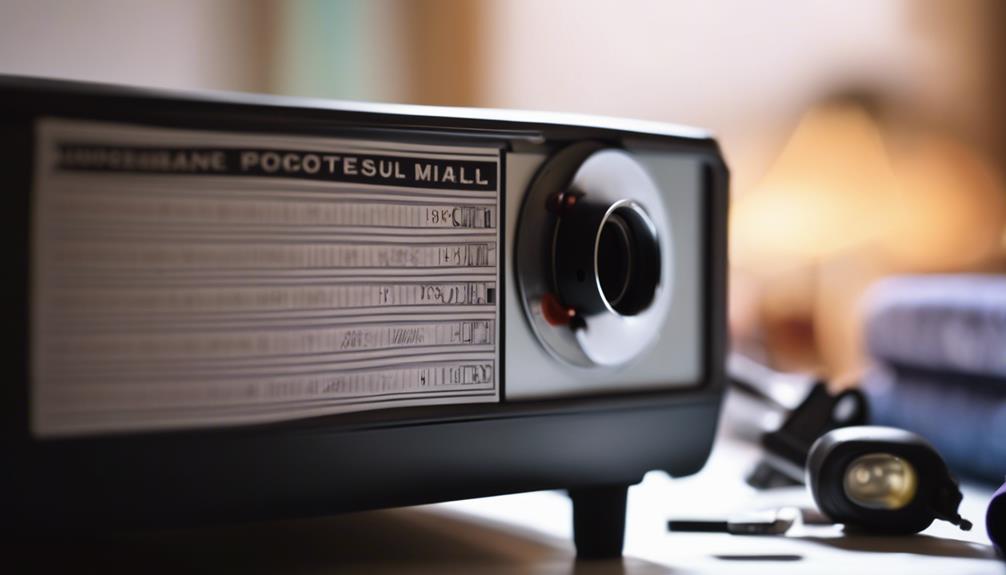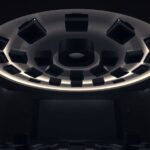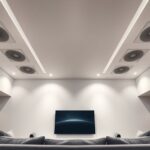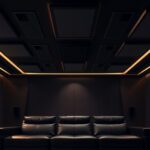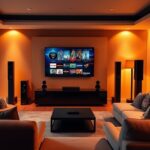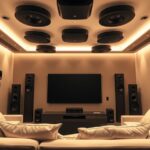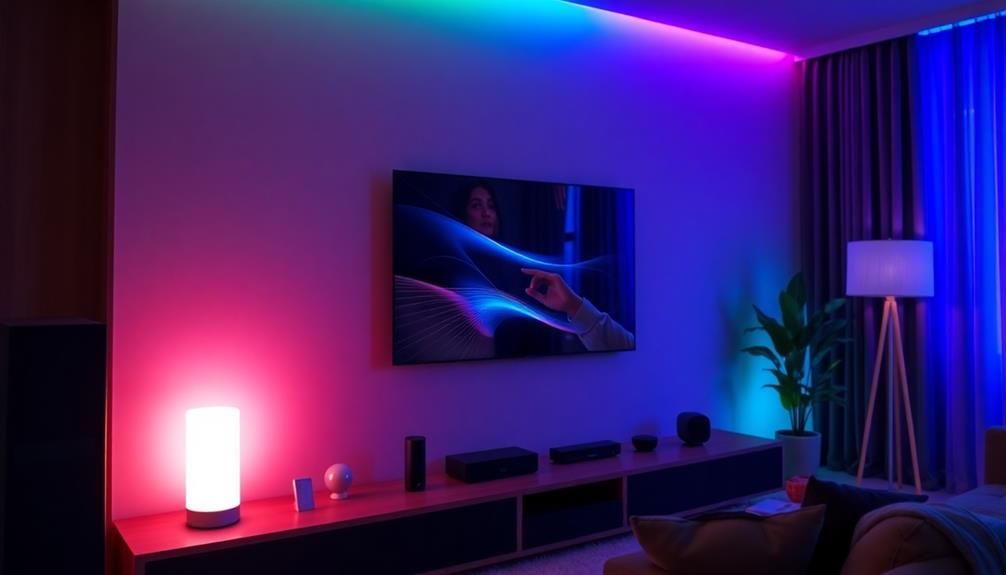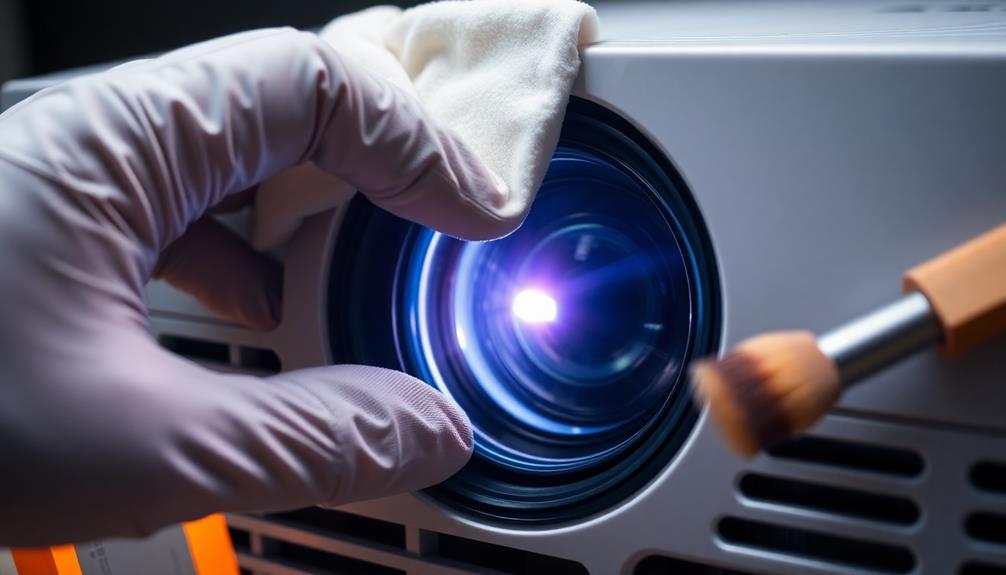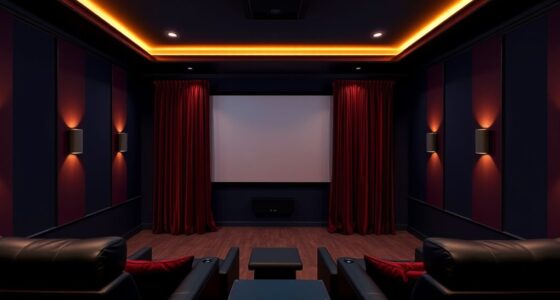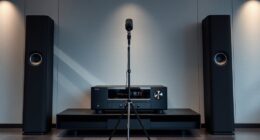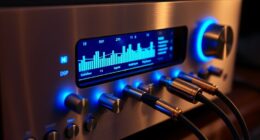Implementing Dolby Atmos in your home cinema dramatically enhances your audio experience, creating a fascinating three-dimensional sound environment. Start by investing in a Dolby Atmos-enabled AV receiver and the right speakers, like ceiling-mounted or upward-firing models. You'll want to position your speakers correctly, focusing on ear-level surrounds and overhead placements for ideal sound distribution. Calibration is key, so use your receiver's tools to fine-tune settings for your specific space. Content is plentiful, with Dolby Atmos available on major streaming services and Blu-rays. Ready to unleash the full potential of your setup? There's so much more to explore about Dolby Atmos!
Key Takeaways
- Dolby Atmos creates a three-dimensional sound environment, allowing for precise audio placement within your home cinema setup.
- Essential equipment includes a Dolby Atmos-enabled AV receiver, compatible speakers, a content source, and quality HDMI cables.
- Recommended speaker configurations range from 5.1.2 to 9.1.2, depending on the desired immersion level and room size.
- Proper calibration and speaker positioning are crucial for optimizing audio quality and achieving a balanced soundstage.
Overview of Dolby Atmos
Dolby Atmos transforms your home cinema experience by creating a three-dimensional sound environment that allows sounds to move freely around you. This immersive audio technology introduces sound objects, which can be precisely placed within the listening space. Unlike traditional audio systems that rely on fixed channels, Dolby Atmos enables sounds to come from above and all around, enriching your home theater system with realistic overhead sounds.
With support for up to 128 audio tracks and management of 64 unique speaker feeds, Dolby Atmos vastly enhances your audio experience. You can enjoy various speaker layouts, including ceiling-mounted speakers or upward-firing modules, ensuring a more dynamic soundstage. This flexibility allows you to customize your setup for ideal immersion.
Since its debut in theaters with Disney/Pixar's "Brave," Dolby Atmos has made its way into consumer devices, including TVs and soundbars. As a result, you'll find a growing library of content in this format, from movies to games, making it an increasingly popular choice for home theater enthusiasts.
Embrace the future of sound with Dolby Atmos and transform how you experience your favorite films and music.
Essential Equipment for Setup

To set up your Dolby Atmos home cinema, you'll need specific hardware components that support this advanced audio format.
You'll want to contemplate your speaker configuration options carefully, as they play an essential role in creating that immersive experience.
Let's explore what equipment you need to get started.
Required Hardware Components
Experiencing the full impact of Dolby Atmos requires several key hardware components that work together for an immersive home cinema setup. To get started, you'll need the following essential equipment:
- Dolby Atmos-enabled AV receiver: This device decodes the object-based audio format for ideal playback.
- Overhead speakers or upward-firing speakers: At least two of these are necessary to create that unparalleled immersive sound experience.
- Blu-ray Player: A high-definition video source, like a Blu-ray player or a compatible streaming service, is essential for accessing Dolby Atmos audio tracks.
Additionally, you'll want a compatible display, such as a TV or projector, to visualize the content while enjoying the enhanced audio.
With these components in place, you'll be well on your way to transforming your home cinema into a fascinating audio-visual experience that truly makes you feel part of the action.
Speaker Configuration Options
Choosing the right speaker configuration is essential for maximizing your Dolby Atmos experience and ensuring immersive sound that envelops you from all directions. To achieve this, consider setups like 5.1.2 or 7.1.2, which require at least two overhead or upward-firing speakers. These configurations allow sound to come from above, enhancing the realism of your audio.
If you want an even deeper immersive experience, you can opt for 5.1.4 or 7.1.4 layouts that include four overhead speakers. This expansion widens the audio field, making it feel like you're in the middle of the action.
Remember, speaker placement is vital; surround speakers should be at ear level, while ceiling speakers must be directly above the listening area for accurate sound mapping.
For those with limited space, integrated units and add-on modules can enhance existing systems, allowing for flexible speaker configurations tailored to your room size. Additionally, soundbars with built-in upward-firing speakers simplify installation, making Dolby Atmos accessible even in compact home theater setups.
Room Setup and Design

Creating an ideal room setup for Dolby Atmos involves careful deliberation of dimensions, speaker placement, and acoustic treatments to guarantee an immersive audio experience.
Start by evaluating your room's size; larger spaces usually need more speakers to achieve optimal sound distribution.
Next, focus on speaker placement. Position your surround speakers at ear level for the best listening experience, while ceiling speakers should be installed directly above the primary listening area for enhanced audio effects.
Incorporate acoustic treatments to improve sound quality. Here are some effective strategies to contemplate:
- Use rugs and curtains to minimize sound distortion.
- Avoid clutter and reflective surfaces that may disrupt audio immersion.
- Make sure that all speakers are positioned correctly to maintain a balanced soundstage.
Calibration and Optimization
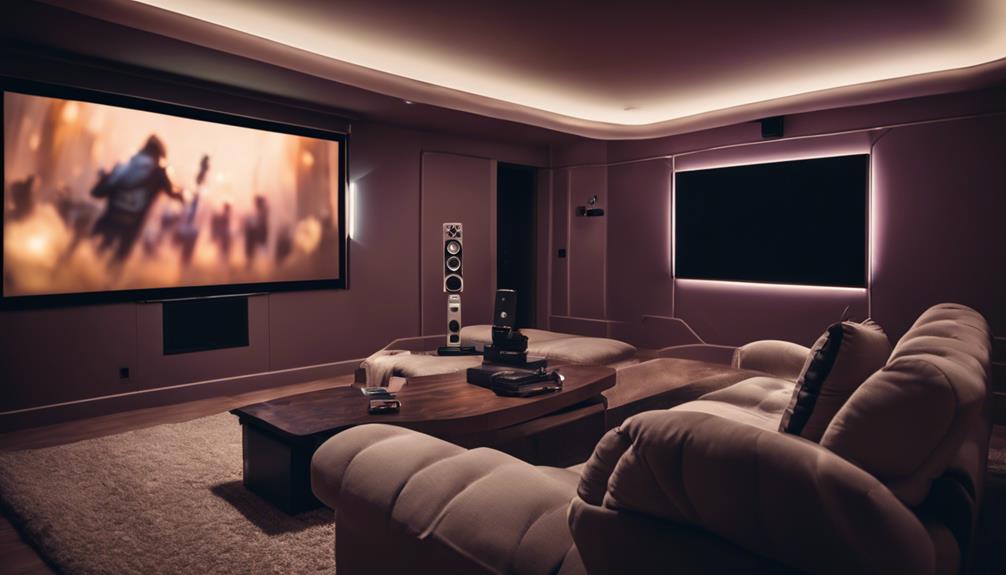
Proper calibration and enhancement of your Dolby Atmos system are vital for achieving the best sound quality tailored to your specific room environment. Start by utilizing calibration tools or built-in features of your Dolby Atmos-enabled AV receiver to adjust your sound settings. These tools can help you assess the functionality and placement of each speaker, guaranteeing ideal sound distribution across your listening area.
Next, focus on speaker placement and tweak settings for distance, level, and crossover frequency based on where your speakers are positioned. This step is significant for creating a balanced and immersive audio experience. Implementing room correction technology, if available, can also enhance audio quality by tailoring sound output to your room's unique acoustics.
Don't forget to keep your AV receiver's firmware and software updated. Regular updates can improve performance and maintain compatibility with new audio formats and technologies. By diligently calibrating and enhancing your system, you'll enjoy a richer, more engaging Dolby Atmos experience that truly brings your home cinema to life.
Content Compatibility
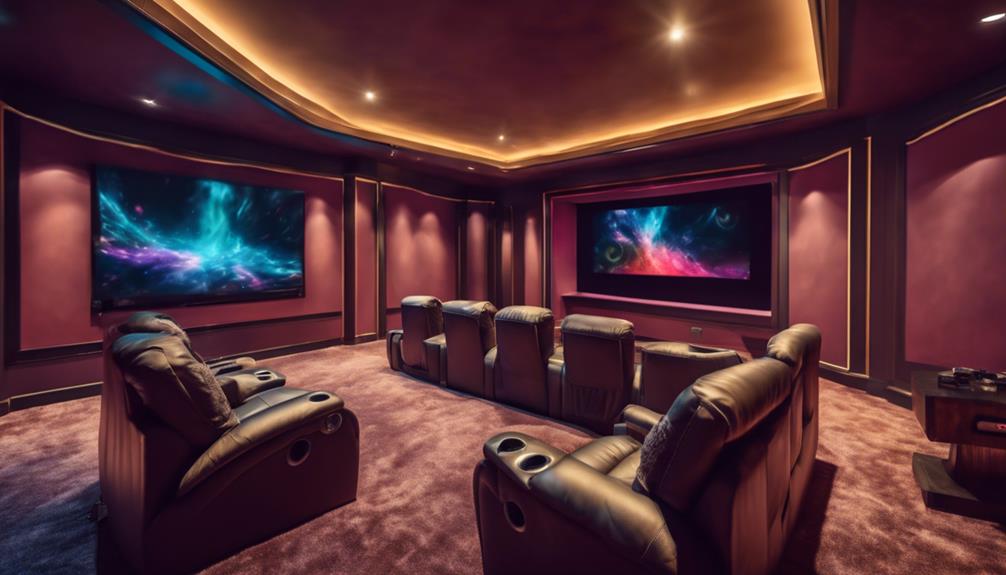
Dolby Atmos content is readily available across various platforms, ensuring you can enjoy an immersive audio experience with your favorite movies, shows, and games. Major streaming services have embraced this technology, providing a wealth of options for you.
Here are some key sources of Dolby Atmos content:
- Streaming Services: Platforms like Netflix, Disney+, and Amazon Prime Video offer an array of Dolby Atmos titles.
- Blu-ray Discs: Many Blu-ray discs come equipped with Dolby Atmos audio tracks, delivering high-quality sounds for home viewing.
- Gaming Consoles: Devices such as Xbox and PlayStation support Dolby Atmos, allowing you to immerse yourself in an audio world in your favorite games.
Content creators are increasingly producing Dolby Atmos content, enhancing your home cinema experience.
To maximize your enjoyment, regularly check for new releases featuring Dolby Atmos to keep your library fresh. With all these options, you're set to enjoy a truly immersive audio experience right from your home.
Speaker Setup Options
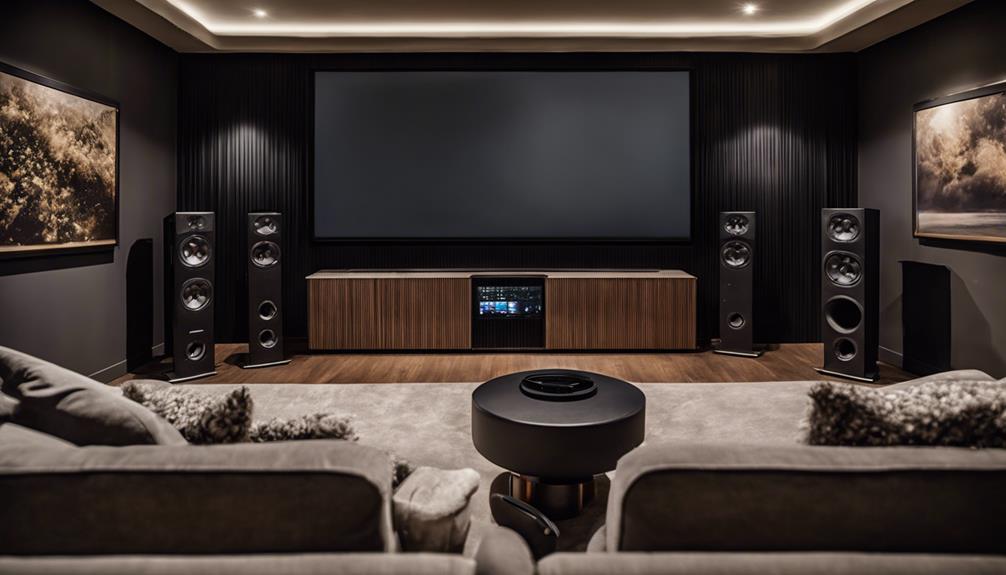
When setting up your home cinema, choosing the right speaker configuration can dramatically enhance your Dolby Atmos experience. You have several options for your speaker setup that can create immersive overhead sound, making you feel like you're right in the middle of the action.
Here's a quick overview of some configurations:
| Speaker Type | Description |
|---|---|
| Ceiling-mounted speakers | Provides direct overhead sound. |
| Upward-firing speakers | Reflects sound off the ceiling for immersion. |
| Integrated units | Add-on modules that enhance existing speakers. |
| Soundbars with height channels | Simplifies setup with built-in upward-firing elements. |
| Basic Dolby Atmos | Minimum of two overhead or Dolby Atmos-enabled speakers. |
For a basic setup, at least two overhead or upward-firing speakers are essential. If you're aiming for something more advanced, consider configurations like 5.1.2 or 7.1.4. These setups include additional height speakers, enhancing the depth of your home theater sound system. Choosing the right speaker setup is key to revealing the full potential of Dolby Atmos in your cinematic experience.
Recommended Speaker Configurations
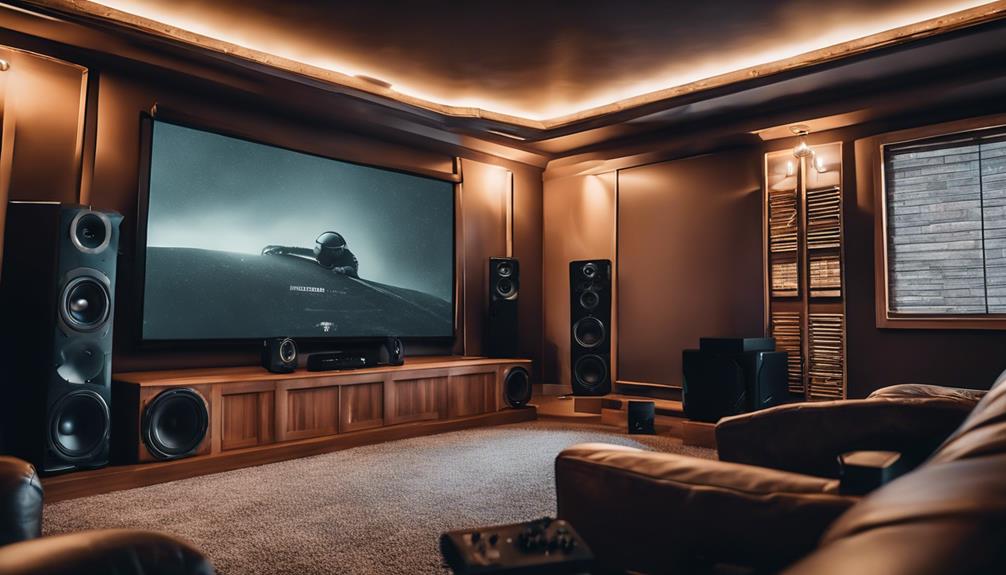
For an ideal home cinema experience, consider a 5.1.2 configuration as a solid starting point for enjoying immersive audio. This setup includes five main speakers, one subwoofer, and two overhead speakers, creating an engaging Dolby Atmos experience. Proper placement is vital; confirm the overhead speakers are directly above the listening area and the surround speakers are at ear level.
If you're looking for enhanced surround sound, you might want to explore these configurations:
- 7.1.2: Adds two additional surround speakers for a richer soundscape.
- 5.1.4: Incorporates four overhead speakers for a deeper immersive setup.
- 7.1.4: Expands further with two extra surround and four overhead speakers.
Each of these speaker configurations elevates your Atmos experience, allowing you to feel enveloped in sound.
Remember, the goal is to create an environment where audio surrounds you, making every movie feel like you're in the middle of the action.
Choose the setup that best meets your space and audio preferences!
Home Vs. Theatrical Atmos
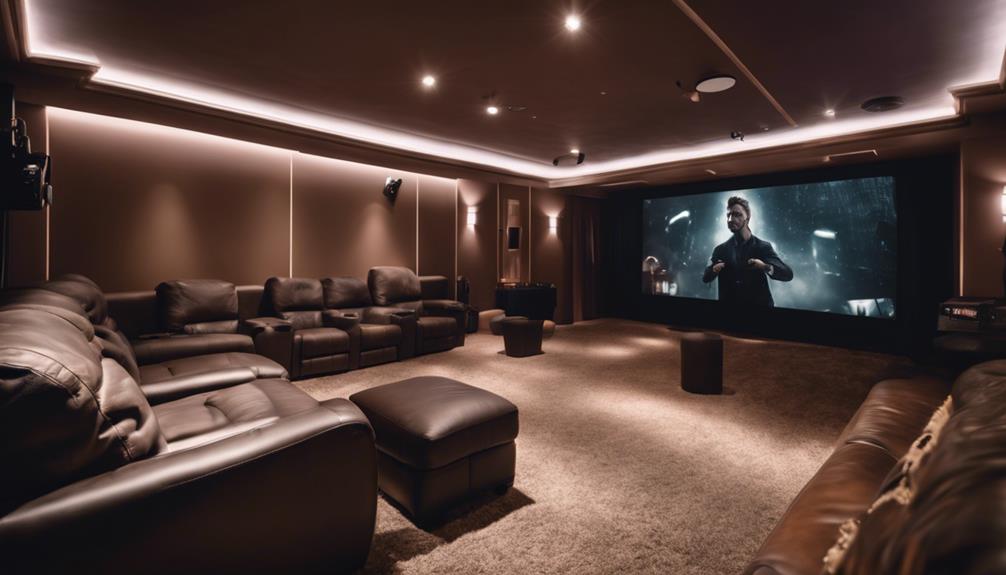
The differences between home and theatrical Atmos setups can greatly impact your audio experience, making it essential to understand their unique capabilities.
In a typical home system, you'll encounter a maximum of 16 audio objects, with only 4 allowed to move freely. In contrast, theatrical systems can handle up to 168 objects, providing more flexibility for dynamic audio placement.
Most home configurations, like the popular 7.1.4 setup, utilize 12 dedicated bed channels, limiting the potential of object-based audio. This often leads to hard-coded tracks that don't showcase the full immersive experience Dolby Atmos can offer. In commercial theaters, you'll find 9.1 bed channels with up to 118 simultaneous sound objects, creating a richer soundscape.
Speaker placement in your home system is vital for maximizing the immersive experience. Unlike theaters that use precise X, Y, Z coordinate mapping, your setup may not replicate this level of precision.
If you have a larger home system, be mindful that exceeding typical configurations can lead to sound output limitations, especially if your expectations don't align with your system's actual performance capabilities. Understanding these differences will help you optimize your home audio experience.
Future of Atmos Technology

Advancements in processing power are set to transform Dolby Atmos technology, enhancing audio experiences in home cinema setups. As the demand for immersive audio grows, you can expect to see significant improvements in speaker configurations and overall audio quality. The future looks promising with several key developments on the horizon:
- Dynamic object handling: More precise control over sound placement within the room.
- Flexible speaker configurations: Adjustments to fit various home environments and preferences.
- Content growth: An expanding library of Dolby Atmos-encoded media, increasing your options for entertainment.
These innovations aim to bridge the gap between cinematic and home audio experiences, making it easier to enjoy Atmos technology in your own space.
Whether it's for movies, music, or live events, the integration of Dolby Atmos will deepen viewer engagement. As industry trends evolve, you'll find that the future of Atmos technology will continually redefine how you experience sound, providing a more immersive and enjoyable home cinema environment.
Frequently Asked Questions
How Do I Use Dolby Atmos on My Home Theater?
To use Dolby Atmos in your home theater, connect a compatible AV receiver and speakers, set up the recommended layout, use quality HDMI cables, access Atmos content, and calibrate your system for ideal sound.
Is Dolby Atmos Good for Home Theater?
Studies show that immersive audio can increase engagement by up to 50%. Dolby Atmos enhances your home theater experience, making sound feel more realistic and enthralling, so you'll truly enjoy every movie and game.
What Do You Need for Dolby Atmos Home Theater?
To set up Dolby Atmos in your home theater, you'll need a compatible AV receiver, specific media sources, overhead or Dolby Atmos-enabled speakers, quality HDMI cables, and proper speaker placement for immersive sound experiences.
What Equipment Do I Need for Dolby Atmos?
You can't immerse yourself in Dolby Atmos without the right gear. You'll need a Dolby Atmos-enabled AV receiver, overhead speakers, high-quality HDMI cables, and compatible media sources to truly enjoy that enchanting sound experience.
Conclusion
Incorporating Dolby Atmos into your home cinema can transform your viewing experience, immersing you in sound like never before.
By understanding the essential equipment, room design, and speaker configurations, you can access the full potential of this technology.
As you calibrate and optimize your setup, you'll discover that the magic of Atmos lies in its ability to create a cinematic atmosphere right in your living room.
Embrace the future of sound, and let your home become the ultimate entertainment destination.

